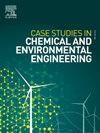Energy-water usage and greenhouse gas emissions nexus of the natural rubber industry in Vietnam
Q1 Environmental Science
Case Studies in Chemical and Environmental Engineering
Pub Date : 2025-06-03
DOI:10.1016/j.cscee.2025.101245
引用次数: 0
Abstract
The natural rubber industry is one of the leading forces in the agro-industry in Vietnam and is expected to expand in response to growing material demands. However, as the industry pursues profit targets, there is also a pressing need to consider its sustainability. One challenge is the lack of detailed information on the life cycle of natural rubber products, particularly regarding energy consumption, which could hinder sustainable practices. Based on an on-site survey of six natural rubber processing companies in the Southeast and Central Highlands of Vietnam, this field research aims to evaluate the sustainability of the natural rubber industry by examining greenhouse gas (GHG) emissions from energy and water consumption throughout the life cycle of all products. Over two years, biogas, wastewater, and sludge samples were collected multiple times from each factory involved in the research and facilitated with both testing the characteristics and components of these samples, as well as calculating their carbon footprint by the 2006 Guidelines of the Intergovernmental Panel on Climate Change (IPCC). GHG emissions from the two most dominant Vietnamese natural rubber products were 589 and 133 kg CO2eq., respectively, generated from each ton of Standard Vietnamese Rubber (SVR) and Centrifuged Latex (CL) products produced. Our study identified three main sources of GHG emissions in the Vietnamese natural rubber industry: high electricity use during the SVR production process, vast ammonia requirements for the CL production process, and direct CH4 and CO2 emissions from the regulation tanks of the wastewater processes. Most surveyed factories have taken significant steps in adopting sustainable practices to reduce their GHG emissions. By combining conventional efforts of factories with GHG emission calculations during this field trip, our research proposes significant energy-saving executions to promote sustainable development in the regional natural rubber industry.
越南天然橡胶工业的能源-水使用和温室气体排放关系
天然橡胶工业是越南农业工业的主导力量之一,预计将扩大以应对不断增长的材料需求。然而,随着该行业追求利润目标,也迫切需要考虑其可持续性。一个挑战是缺乏关于天然橡胶产品生命周期的详细信息,特别是关于能源消耗的信息,这可能会阻碍可持续做法。基于对越南东南部和中部高地的六家天然橡胶加工公司的现场调查,本实地研究旨在通过检查所有产品在整个生命周期中能源和水消耗的温室气体(GHG)排放来评估天然橡胶工业的可持续性。在两年多的时间里,研究人员从参与研究的每个工厂多次收集了沼气、废水和污泥样本,并帮助测试了这些样本的特征和成分,并根据政府间气候变化专门委员会(IPCC) 2006年指南计算了它们的碳足迹。越南两种最主要的天然橡胶产品的温室气体排放量分别为589千克和133千克二氧化碳当量。生产的每吨越南标准橡胶(SVR)和离心乳胶(CL)产品分别产生的。我们的研究确定了越南天然橡胶工业温室气体排放的三个主要来源:SVR生产过程中的高用电量,CL生产过程中的大量氨需求,以及废水处理调节罐直接排放的CH4和CO2。大多数被调查的工厂都采取了重大步骤,采用可持续的做法来减少温室气体排放。通过将工厂的常规努力与实地考察中的温室气体排放计算相结合,我们的研究提出了促进区域天然橡胶工业可持续发展的重大节能措施。
本文章由计算机程序翻译,如有差异,请以英文原文为准。
求助全文
约1分钟内获得全文
求助全文
来源期刊

Case Studies in Chemical and Environmental Engineering
Engineering-Engineering (miscellaneous)
CiteScore
9.20
自引率
0.00%
发文量
103
审稿时长
40 days
 求助内容:
求助内容: 应助结果提醒方式:
应助结果提醒方式:


